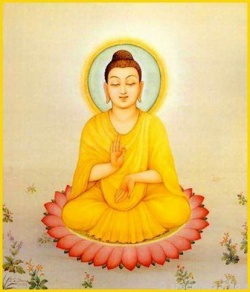Difference between revisions of "Right thought"
| (One intermediate revision by the same user not shown) | |||
| Line 1: | Line 1: | ||
[[File:Boo30tbb.jpg|thumb|250px|]] | [[File:Boo30tbb.jpg|thumb|250px|]] | ||
| − | '''[[Right thought]]''' '''[[Right intention]]''' ([[samyak-saṃkalpa]]/[[sammā sankappa]]) can also be known as "[[right thought]]", "[[right resolve]]", "[[right conception]]", "[[right aspiration]]" or "the {{Wiki|exertion}} of our own will to change". In this factor, the [[practitioner]] should constantly aspire to rid themselves of whatever qualities they [[know]] to be wrong and [[immoral]]. Correct [[understanding]] of [[right view]] will help the [[practitioner]] to discern the differences between [[right intention]] and wrong {{Wiki|intention}}. In the {{Wiki|Chinese}} and [[Pali Canon]], it is explained thus: | + | '''[[Right thought]]''' '''[[Right intention]]''' ([[samyak-saṃkalpa]]/[[sammā sankappa]]) can also be known as "[[right thought]]", "[[right resolve]]", "[[right conception]]", "[[right aspiration]]" or "the {{Wiki|exertion}} of our [[own]] will to change". In this factor, the [[practitioner]] should constantly aspire to rid themselves of whatever qualities they [[know]] to be wrong and [[immoral]]. Correct [[understanding]] of [[right view]] will help the [[practitioner]] to discern the differences between [[right intention]] and wrong {{Wiki|intention}}. In the {{Wiki|Chinese}} and [[Pali Canon]], it is explained thus: |
And what is [[right resolve]]? [[Being]] resolved on [[renunciation]], on freedom from [[ill will]], on [[harmlessness]]: This is called [[right resolve]]. | And what is [[right resolve]]? [[Being]] resolved on [[renunciation]], on freedom from [[ill will]], on [[harmlessness]]: This is called [[right resolve]]. | ||
| Line 10: | Line 10: | ||
The second part of the [[eightfold path]] is [[Right Thought]]. All of the parts are not in any particular [[order]] except that you start with [[Right Understanding]] and end with [[Right Understanding]]. All of the parts are to be performed simultaneously. The [[difference]] with [[Right Understanding]] is simply that you begin with some [[understanding]] of the [[Buddha]]’s teachings and end with an experiential [[understanding]] of the [[Buddha]]’s teachings. All the while all eight parts are treaded simultaneously. | The second part of the [[eightfold path]] is [[Right Thought]]. All of the parts are not in any particular [[order]] except that you start with [[Right Understanding]] and end with [[Right Understanding]]. All of the parts are to be performed simultaneously. The [[difference]] with [[Right Understanding]] is simply that you begin with some [[understanding]] of the [[Buddha]]’s teachings and end with an experiential [[understanding]] of the [[Buddha]]’s teachings. All the while all eight parts are treaded simultaneously. | ||
[[File:B13.jpg|thumb|250px|]] | [[File:B13.jpg|thumb|250px|]] | ||
| − | The [[Buddha]] described two types of [[thought]]; wandering [[thought]] ([[vicàra]]) and {{Wiki|logical}} or directed [[thought]] ([[vitakka]]). Normally our [[mind]] is filled with scattered, random, wandering [[thoughts]] and we have little say in what they are or what they will be next. When we have a task to do or a problem to solve, the will takes hold of and directs our [[thoughts]] in a particular [[direction]]. But usually, as soon as the task is finished or the problem solved, the will subsides and [[thoughts]] begin their erratic wandering again. The [[Buddha]] made the important but often overlooked observation that, ‘Whatever one [[thinks]] about and ponders on often the [[mind]] gets a leaning in that way’ (M.I,115). The more of a particular type of [[thoughts]] we think, the more they will occur. If we often have [[thoughts]] of [[greed]] and allow them to persist they will tend to occupy our [[mind]] more frequently and we may begin to act in a more [[greedy]] [[manner]]. Therefore an important aspect of [[Buddhist]] training is to cultivate [[Right Thought]], not to let negative [[thoughts]] persist within our [[mind]] and to encourage positive [[thoughts]]. The [[Buddha]] broadly defines [[Right Thought]] as [[thoughts]] of [[detachment]], of [[love]] and of helpfulness (M.III,251). [[Right Concentration]], [[Right Mindfulness]] and [[Right Effort]] are of course important in helping the development of [[Right Thought]]. | + | The [[Buddha]] described two types of [[thought]]; wandering [[thought]] ([[vicàra]]) and {{Wiki|logical}} or directed [[thought]] ([[vitakka]]). Normally our [[mind]] is filled with scattered, random, wandering [[thoughts]] and we have little say in what they are or what they will be next. When we have a task to do or a problem to solve, the will takes hold of and directs our [[thoughts]] in a particular [[direction]]. But usually, as soon as the task is finished or the problem solved, the will subsides and [[thoughts]] begin their erratic wandering again. The [[Buddha]] made the important but often overlooked observation that, ‘Whatever one [[thinks]] about and ponders on often the [[mind]] gets a leaning in that way’ (M.I,115). The more of a particular type of [[thoughts]] we think, the more they will occur. If we often have [[thoughts]] of [[greed]] and allow them to persist they will tend to occupy our [[mind]] more frequently and we may begin to act in a more [[greedy]] [[manner]]. Therefore an important aspect of [[Buddhist]] {{Wiki|training}} is to cultivate [[Right Thought]], not to let negative [[thoughts]] persist within our [[mind]] and to encourage positive [[thoughts]]. The [[Buddha]] broadly defines [[Right Thought]] as [[thoughts]] of [[detachment]], of [[love]] and of helpfulness (M.III,251). [[Right Concentration]], [[Right Mindfulness]] and [[Right Effort]] are of course important in helping the [[development]] of [[Right Thought]]. |
| − | [[Right Thought]] includes [[thoughts]] of [[love]] and [[non-violence]] extending to all [[beings]]. In [[vipassana]] [[meditation]] [[awareness]] is placed on [[thoughts]] with intent to cease [[thoughts]] so that the [[meditation]] remains in the {{Wiki|present}} moment free from [[unwholesome]] [[thoughts]]. [[Right Thought]] basically refers to [[wholesome]] [[thoughts]], which is closely tied to [[Right Understanding]] because it results eventually through the practice and [[attainment]] of [[wisdom]]. | + | [[Right Thought]] includes [[thoughts]] of [[love]] and [[non-violence]] extending to all [[beings]]. In [[vipassana]] [[meditation]] [[awareness]] is placed on [[thoughts]] with intent to cease [[thoughts]] so that the [[meditation]] remains in the {{Wiki|present}} [[moment]] free from [[unwholesome]] [[thoughts]]. [[Right Thought]] basically refers to [[wholesome]] [[thoughts]], which is closely tied to [[Right Understanding]] because it results eventually through the [[practice]] and [[attainment]] of [[wisdom]]. |
[[File:Be1de911.jpg|thumb|250px|]] | [[File:Be1de911.jpg|thumb|250px|]] | ||
| − | The first two verses of the first chapter of the [[Dhammapada]] by the [[Buddha]], are: | + | The first two verses of the first [[chapter]] of the [[Dhammapada]] by the [[Buddha]], are: |
“All we are is the result of what we have [[thought]], it is founded on our [[thoughts]], it is made up of our [[thoughts]]. If a man speaks or acts with a [[pure]] [[thought]], [[happiness]] follows him like a shadow that never leaves him.” | “All we are is the result of what we have [[thought]], it is founded on our [[thoughts]], it is made up of our [[thoughts]]. If a man speaks or acts with a [[pure]] [[thought]], [[happiness]] follows him like a shadow that never leaves him.” | ||
| − | Our [[thoughts]] are as important to us as our [[actions]] because they make up who we are, thus, it becomes imperative that we keep our [[thoughts]] [[pure]]. | + | Our [[thoughts]] are as important to us as our [[actions]] because they make up who we are, thus, it becomes {{Wiki|imperative}} that we keep our [[thoughts]] [[pure]]. |
An example is to [[imagine]] if your [[thoughts]] are filled with [[money]] and how to get more [[money]]. [[Greed]] becomes a big part of your [[life]]. It defines who you are. Your [[thoughts]] become fixated on [[money]] and this is who you become. | An example is to [[imagine]] if your [[thoughts]] are filled with [[money]] and how to get more [[money]]. [[Greed]] becomes a big part of your [[life]]. It defines who you are. Your [[thoughts]] become fixated on [[money]] and this is who you become. | ||
| Line 30: | Line 30: | ||
Another quote from the [[Buddha]] in regard to the value of [[Right Thought]] is: | Another quote from the [[Buddha]] in regard to the value of [[Right Thought]] is: | ||
| − | “Your worst enemy can not harm you as much as your own [[thoughts]], unguarded. But once mastered, no one can help you as much, not even your father or your mother.” (Dh., chapter 3) | + | “Your worst enemy can not harm you as much as your [[own]] [[thoughts]], unguarded. But once mastered, no one can help you as much, not even your father or your mother.” (Dh., [[chapter]] 3) |
{{W}} | {{W}} | ||
[[Category:Noble Eightfold Path]] | [[Category:Noble Eightfold Path]] | ||
[[Category:Thought]] | [[Category:Thought]] | ||
Latest revision as of 23:19, 26 March 2015
Right thought Right intention (samyak-saṃkalpa/sammā sankappa) can also be known as "right thought", "right resolve", "right conception", "right aspiration" or "the exertion of our own will to change". In this factor, the practitioner should constantly aspire to rid themselves of whatever qualities they know to be wrong and immoral. Correct understanding of right view will help the practitioner to discern the differences between right intention and wrong intention. In the Chinese and Pali Canon, it is explained thus:
And what is right resolve? Being resolved on renunciation, on freedom from ill will, on harmlessness: This is called right resolve.
It means the renunciation of the worldly things and an accordant greater commitment to the spiritual path; good will; and a commitment to non-violence, or harmlessness, towards other living beings.
Right Thought (sammà samkappa) is the second step on the Buddha’s Noble Eightfold Path. Thoughts are either words or pictures that form in the mind and which are often accompanied by or give rise to feelings which in turn may give rise to actions.
The second part of the eightfold path is Right Thought. All of the parts are not in any particular order except that you start with Right Understanding and end with Right Understanding. All of the parts are to be performed simultaneously. The difference with Right Understanding is simply that you begin with some understanding of the Buddha’s teachings and end with an experiential understanding of the Buddha’s teachings. All the while all eight parts are treaded simultaneously.
The Buddha described two types of thought; wandering thought (vicàra) and logical or directed thought (vitakka). Normally our mind is filled with scattered, random, wandering thoughts and we have little say in what they are or what they will be next. When we have a task to do or a problem to solve, the will takes hold of and directs our thoughts in a particular direction. But usually, as soon as the task is finished or the problem solved, the will subsides and thoughts begin their erratic wandering again. The Buddha made the important but often overlooked observation that, ‘Whatever one thinks about and ponders on often the mind gets a leaning in that way’ (M.I,115). The more of a particular type of thoughts we think, the more they will occur. If we often have thoughts of greed and allow them to persist they will tend to occupy our mind more frequently and we may begin to act in a more greedy manner. Therefore an important aspect of Buddhist training is to cultivate Right Thought, not to let negative thoughts persist within our mind and to encourage positive thoughts. The Buddha broadly defines Right Thought as thoughts of detachment, of love and of helpfulness (M.III,251). Right Concentration, Right Mindfulness and Right Effort are of course important in helping the development of Right Thought.
Right Thought includes thoughts of love and non-violence extending to all beings. In vipassana meditation awareness is placed on thoughts with intent to cease thoughts so that the meditation remains in the present moment free from unwholesome thoughts. Right Thought basically refers to wholesome thoughts, which is closely tied to Right Understanding because it results eventually through the practice and attainment of wisdom.
The first two verses of the first chapter of the Dhammapada by the Buddha, are:
“All we are is the result of what we have thought, it is founded on our thoughts, it is made up of our thoughts. If a man speaks or acts with a pure thought, happiness follows him like a shadow that never leaves him.”
Our thoughts are as important to us as our actions because they make up who we are, thus, it becomes imperative that we keep our thoughts pure.
An example is to imagine if your thoughts are filled with money and how to get more money. Greed becomes a big part of your life. It defines who you are. Your thoughts become fixated on money and this is who you become.
Another example is a person with what is commonly called, “a one track mind.” Such a person focuses his mind and thoughts on only one topic. All of this person’s conversation tends to run on this one subject. It begins with the thoughts and then permeates to define that person.
An optimistic person is one who sees things in a positive way. This person radiates happiness and loving kindness. Such a person greets people with a smile and it is from the heart and not just conformation to etiquette. This positive attitude had its start with good, positive thoughts.
By keeping our thoughts wholesome and in the present we encourage only productive thoughts. Thoughts can then be useful and not counter-productive.
Another quote from the Buddha in regard to the value of Right Thought is:
“Your worst enemy can not harm you as much as your own thoughts, unguarded. But once mastered, no one can help you as much, not even your father or your mother.” (Dh., chapter 3)


